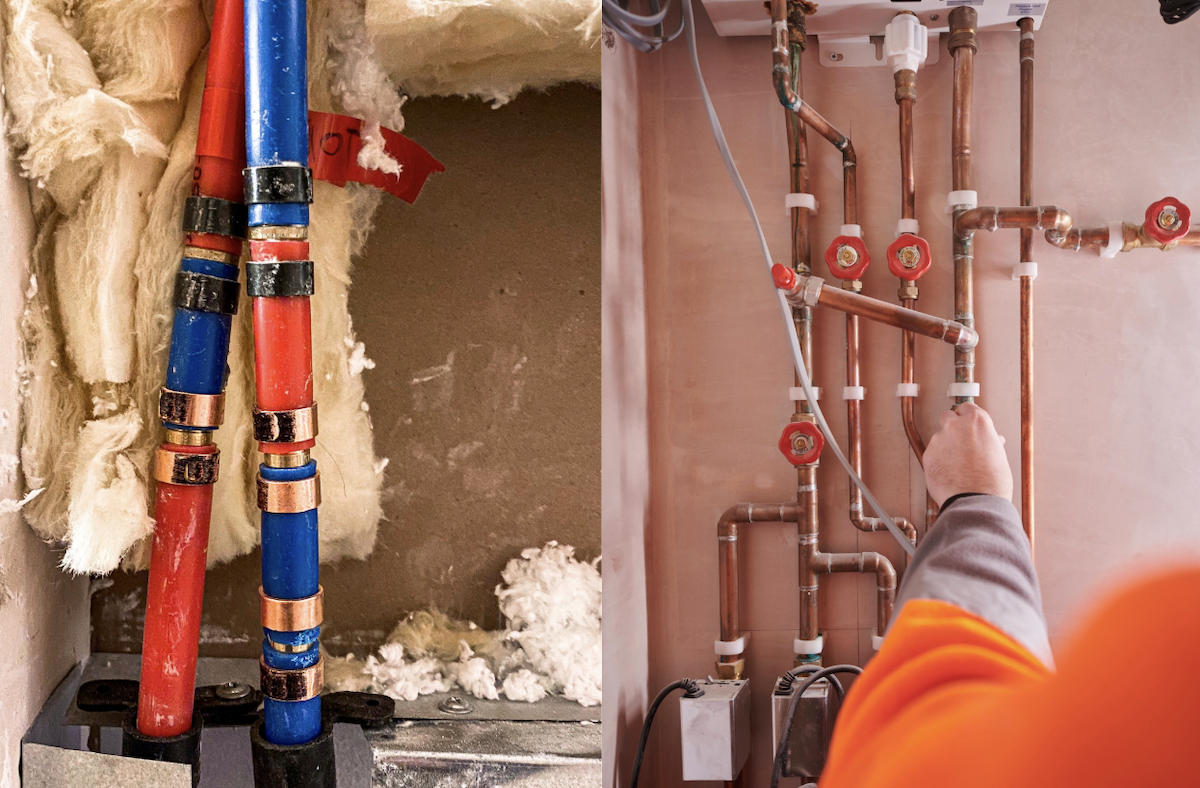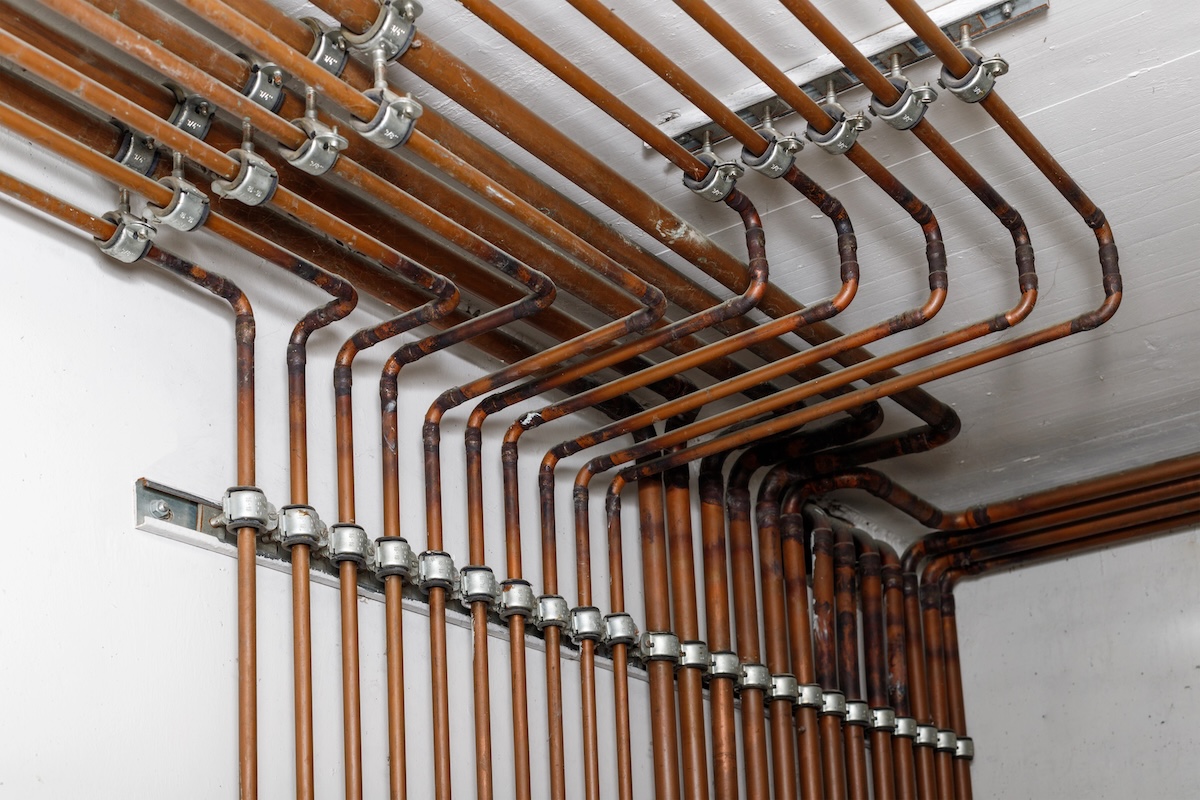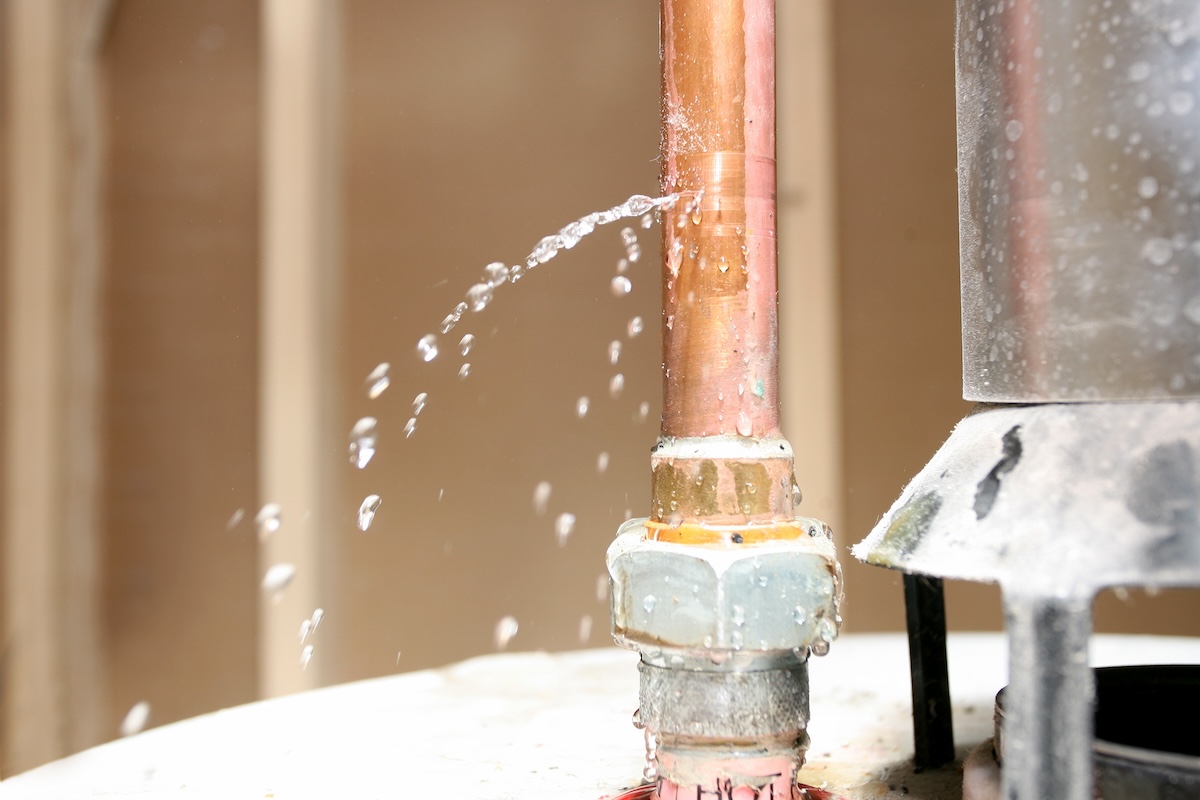

We may earn revenue from the products available on this page and participate in affiliate programs. Learn More ›
Plumbing systems are essential for creating pathways to dispense water to faucets, showers, baths, toilets, and any water-using appliances throughout the home, but there is some variation in the types of pipes you can choose for your home. Copper pipes have long been the go-to option due to the high level of durability, resistance to corrosion, and recyclability.
However, PEX pipe has started to fill gaps in function that copper pipe could not, such as flexibility and ease of installation, allowing even DIYers to install PEX without needing to worry about using a blow torch or soldering. Discover the differences between PEX vs copper in this guide, so you can have all necessary information to decide which is right for your home.
What is copper piping?

When considering whether to use PEX pipe vs copper, it’s important to have a basic understanding of what each material actually is and how it can benefit your home. There are several types of copper pipe, but ultimately each type can be described as a seamless tube or pipe made of copper that can be joined with other pieces of copper pipe using copper or brass fittings that are typically soldered together, though you can also use compression fittings in some circumstances.
In a direct comparison between copper vs PEX, copper has a longer lifespan, so you can count on it to still be in good condition for several decades longer than PEX. Copper is also more sustainable, making it a great resource for eco-conscious individuals, and it has a higher resistance to pests and UV radiation than PEX. With this in mind, plumbers often use copper in situations where the pipe will be exposed to UV radiation, pest activity, or in which the customer prefers a product that lasts long and can be recycled at the end of its lifespan.
What is PEX piping?

PEX pipe is flexible tubing or pipe made of cross-linked polyethylene, which has become popular for its use in plumbing and radiant heating systems. It’s common for homeowners to ask: Should I use copper or PEX? The main reason this question is often asked is simply due to PEX being a relatively new product, as well as the poor reputation early PEX material was known for before changes were made to create a safer, longer-lasting product.
The current PEX pipe is completely safe for drinking water and while it cannot last as long as copper, it does have a long life, making it worth the investment. When it comes to the cost of PEX vs copper piping, PEX is the more affordable choice by a wide margin, making it a great choice if you are replacing the existing copper pipes or adding plumbing lines to a new home. PEX is also less likely to freeze, which is why it is often used for homes and businesses in colder climates. This type of plumbing pipe is also easier to install, with simple-to-use fasteners and a central manifold for ease of operation.
Comparing Copper and PEX Piping

Deciding on whether to invest in PEX vs copper plumbing is partially dependent on your personal preferences, but take into consideration the longevity, cost, versatility, operation, installation, and sustainability. Also consider exposure to rodents, UV radiation, extreme heat, and freezing conditions. After weighing these factors, you will be in a better place to make an informed decision between PEX water line vs copper.
| Copper | PEX | |
| Longevity | Lasts 50 to 70 years | Lasts 30 to 50 years |
| Cost | $2 to $8 per linear foot | $0.50 to $2 per linear foot |
| Versatility | Rigid structure, difficult to maneuver | Flexible structure, easy to run through tight spaces |
| Operation | Multiple individual shut-off valves, with a single whole-house shut-off | Multiple shut-off valves located on the water-distribution manifold |
| Durability | Resistant to rodents, heat, and UV radiation | Resistant to chemical corrosion and freezing |
| Installation | Soldering required to create connections and install valves | Crimp, clamp, and push-to-connect fittings and valves |
| Sustainability | Highly recyclable, but requires more energy to produce | Difficult to recycle, but requires less energy to produce |
Longevity
It’s tough to beat copper pipes for longevity, which on average last 50 to 70 years, compared to PEX, which has an expected lifespan of 30 to 50 years. PEX’s life expectancy can be shortened by the use of extremely hot household water (180 degrees Fahrenheit or higher) or if the water in the home contains high levels of chlorine.
Copper’s life can be shortened by highly acidic water. When installed under typical conditions (i.e., your home is connected to a municipal water system), copper can be expected to outlast PEX by about 20 years. If you’re on a private well, have your water tested prior to retrofitting your water supply system. Local county extension offices can test well water to determine whether it’s high in acid or chlorine.
Cost
In recent years, the cost of copper has risen substantially due to its increased recycle value, so products made from copper have increased in price as well. On average, installing copper water pipes will be 58 percent to 68 percent more expensive than PEX. For example, you could expect to pay $8,000 to $10,000 to have a plumber replace the old pipes with new copper pipes in an average, two-bath, 1,500-square-foot home versus $4,000 to $6,000 for PEX.
Typically, copper costs about $2 to $8 per linear foot, while PEX costs about $0.50 to $2 per linear foot, making it well worth the investment to replace old copper pipes with PEX. However, if the home has had frequent problems with pests, it may be better to go with copper pipe, since rodents chew PEX pipe, which is why even plumbers don’t have a strong preference between PEX or copper, since the best material is situation-dependent.
Versatility
Since it is rigid, copper pipe must be cut to size and have elbow fittings installed every time it comes to a corner, such as where it turns from a vertical run between studs to a horizontal run to meet a sink. More connections mean more installation labor. PEX, on the other hand, runs continuously all the way from a water-distribution panel (called a manifold) to each fixture (tub, sink, etc.). PEX tools are easy to use and the pipe bends easily around corners so no additional connections are necessary.
In a remodeling project, flexibility is a big plus, because the PEX pipe can be snaked through finished walls without the need to cut out drywall. To have new copper pipes installed in a finished home, the drywall must be removed to give the plumber access to make connections.
Operation
Most water fixtures, such as tubs, sinks, and showers, have individual shut-off valves located somewhere nearby. In the case of a sink, it’s usually in the vanity cabinet below, but shut-off valves for tubs and showers are often located behind access panels held in place with screws, making it a chore to access them.
With PEX, every pipe connects to the water-distribution manifold (usually located near where the water main enters the house), and each individual pipe has its own shutoff valve directly on the manifold. The manifold features labels for each shutoff valve, such as “bathtub” or “laundry room sink,” so turning the water supply off and on for any fixture is simple.
Durability

One of the biggest disadvantages of copper pipes is their tendency to crack if the water in the pipes freezes and expands. Having a degree of flexibility, PEX is able to expand if the water inside it freezes, making PEX more resistant to freeze-breakage. Copper is also more vulnerable to corrosion than PEX pipe is, which is why PEX is a better choice for homes with hard water.
However, if the plumbing lines will be exposed to UV radiation or high temperatures, then it’s better to invest in copper. Similarly, if the home has a history of rodent infestations, then PEX is a poor choice, since rodents have a tendency to chew on PEX piping, which could lead to hidden leaks and flooding.
Installation
For DIYers, PEX is the easier type of pipe to install. Making the connections necessary in copper pipes requires the use of a torch to solder the connections. If you make a mistake or you are taking apart an existing connection, then you may also need to learn how to sweat copper pipe to avoid wasting parts.
PEX pipes connect with a number of easy-to-use fittings, including quick-connect fittings that connect just by pushing them together, crimp fittings (requiring a special crimp tool), or clamp fittings (calling for a clamp tool).
Manufacturers of each type of fitting usually feature detailed installation videos on their websites, and since PEX is flexible, you’ll only need to make two connections for each fixture—one at the manifold, and the other at the fixture itself.
Note: Permission to install new plumbing in your own home depends on the building codes in your community, so contact your local building authority before you start.
Sustainability
When it comes to sustainability, there are several key points to consider that make it difficult to determine which material is truly more sustainable. The most basic consideration is recyclability. Copper is a highly recyclable material that can be melted down and turned into new materials with relative ease, while PEX has only recently been deemed recyclable, and the process to recycle it is both difficult and time-consuming.
However, it takes more energy to manufacture copper than it does PEX, resulting in lower greenhouse gas emissions when producing PEX. Similarly, PEX doesn’t require as many fittings for installation, reducing waste during installation. Though, copper lasts longer than PEX, so as long as it is properly maintained, copper pipe doesn’t need to be replaced as frequently.
Final Thoughts
There are several key factors to consider when you are deciding between PEX vs copper. By factoring these points into your decision-making process as well as considering the environment in which the pipes will be installed and the level of skill the installer has going into the project, you will be able to make an informed choice between these two common plumbing options.
Generally, homeowners should consider the longevity, cost, versatility, operation, installation, sustainability, and exposure to rodents, UV radiation, extreme heat, freezing conditions, and the presence of hard water. If the home has hard water, is relatively safe from rodent infestations, is located in a colder climate, and the plumbing will not be exposed to UV radiation or extreme heat, then PEX is the best choice. However, if the home is in a warmer part of the country where freezing is less of a concern, or there is a chance that the pipes may be at risk of UV, heat, or rodent damage, then copper is a better option.
